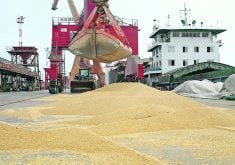SASKATOON — Canada’s canola growers could soon be facing stiff competition in their top seed market.
Reuters is reporting that Australia is close to finalizing an agreement that will reopen the Chinese market to canola shipments from Down Under.
The world’s second-largest canola exporter has been shut out of the largest import market since 2020 due to phytosanitary requirements aimed at preventing the spread of blackleg disease.
China is allowing Australian exporters to ship five trial canola cargoes, according to Reuters.
The shipments would carry between 150,000 and 200,000 tonnes of Australian canola.
Read Also

More factors affecting winter weather
When you combine a weak La Niña, early Siberian snow, and a warm northern Pacific, it’s easy to see why long-range winter forecasting is so complex.
It follows smaller test deliveries last year when Australia exported 500 tonnes of canola to China in both June and July 2024, according to Reuters.
Marlene Boersch, managing partner of Mercantile Consulting Venture, said the news should not come as a surprise to Canadian farmers and exporters.
China has been attempting to diversify its supply chain for five years.
“It’s clearly to their advantage to have as many sources as possible,” she said.
It is a logical response to trade irritants such as Canada’s tariffs on Chinese electric vehicles, steel and aluminum, said Boersch.
She said the proposed Australia-China pact will increase competition for Canada’s canola growers in that key market.
“Australia is primarily focusing on Europe with their shipments, but look at their location,” said Boersch.
The volumes shipped by Australia to China will depend on how price competitive they are into that market compared to Canada.
China imported 432,000 tonnes of canola from Australia in 2020, the last big year for trade between the two countries.
That is a far cry from filling China’s annual import demand for the crop, which has averaged four million tonnes per year over the past five years.
Australia’s proposed phytosanitary deal comes at a time when China could be close to concluding its anti-dumping investigation into Canadian canola exports.
That investigation was launched in September 2024.
A similar antidumping investigation into Australia’s barley exports took 18 months.
If the Canadian canola investigation lasted the same amount of time, that would have it wrapping up in March 2026, toward the end of the upcoming 2025-26 crop year.
The Australian barley investigation resulted in China implementing an 80.5 per cent antidumping tariff that was in place for nearly three years. The tariff was finally removed on Aug. 5, 2023.
Dennis Voznesenski, agricultural economist with the Commonwealth Bank of Australia, thinks China could announce the results of its Canadian investigation as soon as the fourth quarter of 2025.
“If China ceases buying Canadian canola, it could restart buying Australian canola,” he said in his latest Agri Commodity Weekly Alert.
Boersch doesn’t think China will proceed with tariffs on Canadian canola until it knows where it stands with the United States on a trade deal because that will determine how much soybean trade it has with the U.S.
The U.S. recently indicated that it will likely extend its Aug. 12 deadline for a final trade deal with China.
As long as there is no agreement between those two countries, China will probably “quite like our canola,” she said.
Australia plans to be a bigger player in the canola market in the years ahead.
The Australian Oilseed Federation is forecasting that farmers will be producing 8.1 million tonnes of the crop by 2035, up from 5.44 million tonnes in 2024-25.
It is forecasting 5.6 million tonnes of exports by that time, up from five million tonnes today.
As well, it plans to be crushing 1.25 million tonnes domestically by 2035.
















